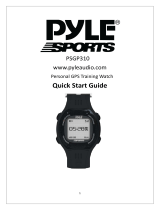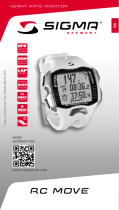
Table of Contents
Introduction.....................................................................1
Keys............................................................................................ 1
Charging the Device................................................................... 1
Pairing Your Smartphone with Your Device............................... 1
Support and Updates.................................................................. 1
Setting Up Garmin Express................................................... 1
Activities......................................................................... 1
Starting an Activity...................................................................... 2
Stopping an Activity.................................................................... 2
Skiing.......................................................................................... 2
Going Cross-Country Skiing.................................................. 2
Going Downhill Skiing or Snowboarding................................ 2
Viewing Your Ski Runs......................................................2
Hiking.......................................................................................... 2
Going for a Hike..................................................................... 2
Running...................................................................................... 2
Going for a Run......................................................................2
Running with the Metronome................................................. 2
Biking.......................................................................................... 3
Going for a Ride..................................................................... 3
Swimming................................................................................... 3
Going for a Pool Swim........................................................... 3
Swim Terminology.............................................................3
Stroke Types..................................................................... 3
Resting During Pool Swimming.........................................3
Training with the Drill Log..................................................3
Going for an Open Water Swim............................................. 3
Multisport.................................................................................... 4
Starting a Triathlon or Multisport Activity............................... 4
Creating a Multisport Activity................................................. 4
Indoor Activities.......................................................................... 4
Navigation....................................................................... 4
Saving Your Location................................................................. 4
Navigating to a Destination......................................................... 4
Navigating with Sight 'N Go........................................................ 4
Compass.....................................................................................4
Map............................................................................................. 4
Panning and Zooming the Map.............................................. 4
Navigating To Your Starting Point.............................................. 5
Altimeter and Barometer............................................................. 5
Training........................................................................... 5
Setting Up Your User Profile.......................................................5
Fitness Goals......................................................................... 5
About Heart Rate Zones........................................................ 5
Setting Your Heart Rate Zones......................................... 5
Heart Rate Zone Calculations........................................... 5
About Lifetime Athletes.......................................................... 5
Activity Tracking..........................................................................5
Turning On Activity Tracking.................................................. 5
Using the Move Alert..............................................................6
Auto Goal............................................................................... 6
Sleep Tracking....................................................................... 6
Using Sleep Mode............................................................. 6
Workouts.....................................................................................6
Following a Workout From the Web.......................................6
Starting a Workout................................................................. 6
About the Training Calendar.................................................. 6
Using Garmin Connect Training Plans.............................. 6
Interval Workouts........................................................................ 6
Creating an Interval Workout................................................. 6
Starting an Interval Workout.................................................. 6
Stopping an Interval Workout................................................ 7
Using Virtual Partner®................................................................ 7
Setting a Training Target
............................................................ 7
Cancelling a Training Target.................................................. 7
Racing a Previous Activity.......................................................... 7
Personal Records....................................................................... 7
Viewing Your Personal Records............................................ 7
Restoring a Personal Record................................................. 7
Clearing a Personal Record................................................... 7
Clearing All Personal Records............................................... 7
Running Dynamics......................................................................7
Training with Running Dynamics........................................... 8
Color Gauges and Running Dynamics Data.......................... 8
Tips for Missing Running Dynamics Data.............................. 8
About VO2 Max. Estimates.........................................................8
Getting Your VO2 Max. Estimate for Running....................... 8
Getting Your VO2 Max. Estimate for Cycling......................... 9
VO2 Max. Standard Ratings.................................................. 9
Viewing Your Predicted Race Times..................................... 9
Recovery Advisor........................................................................9
Turning On the Recovery Advisor.......................................... 9
Viewing Your Recovery Time.................................................9
About Training Effect.................................................................. 9
History........................................................................... 10
Using History............................................................................ 10
Multisport History................................................................. 10
Viewing Your Time in Each Heart Rate Zone...................... 10
Viewing Step Totals.................................................................. 10
Viewing Data Totals.................................................................. 10
Deleting History........................................................................ 10
Clock.............................................................................. 10
Setting the Alarm...................................................................... 10
Starting the Countdown Timer.................................................. 10
Using the Stopwatch................................................................. 10
Connected Features..................................................... 10
Enabling Bluetooth Notifications............................................... 11
Viewing Notifications............................................................ 11
Managing Notifications.........................................................11
Turning Off Bluetooth Technology....................................... 11
Garmin Connect........................................................................11
Using Garmin Connect Mobile............................................. 11
Using Garmin Connect on Your Computer.......................... 11
Wi‑Fi® Connected Features..................................................... 11
Setting Up Wi‑Fi Connectivity.............................................. 11
Connect IQ Features.................................................... 11
Downloading Connect IQ Features.......................................... 12
Downloading Connect IQ Features Using Your Computer....... 12
Widgets..................................................................................... 12
Viewing Widgets.................................................................. 12
VIRB™ Remote................................................................... 12
Controlling a VIRB Action Camera.................................. 12
Customizing Your Device............................................ 12
Activity App Settings................................................................. 12
Customizing the Data Screens............................................ 12
Adding a Map to an Activity................................................. 13
Alerts.................................................................................... 13
Setting an Alert................................................................13
Enabling Auto Pause®......................................................... 13
Auto Lap®............................................................................ 13
Marking Laps by Distance............................................... 13
3D Speed and Distance....................................................... 14
Using Auto Scroll................................................................. 14
UltraTrac.............................................................................. 14
Power Save Timeout Settings..............................................14
Watch Face Settings.................................................................14
Customizing the Watch Face............................................... 14
Table of Contents i






















